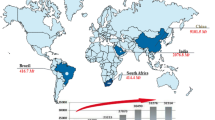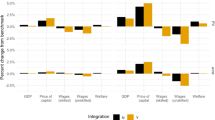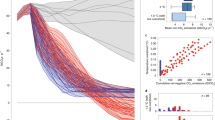Abstract
In this study, we incorporate a three-reservoir climate module into our energy-economy-environmental integrated (3E-integrated) system model, in order to estimate the effect of China’s contribution of unilateral emissions on global warming and to weigh the macro-mitigation cost against the risk of damage, and we also explore the role of adaptation in reducing climate change risk. Our results suggest that China’s unilateral emission-control action plays a relatively limited role in mitigating global warming and is not particularly cost-effective, given that the macro-reduction cost is much larger than the benefit in the corresponding climate damage mitigation. Adaptation plays a large role in curbing China’s climate damages and improving the economics of China’s unilateral emission-control actions, and it is little affected by the introduction and option mitigation strategies. To prevent global warming from exceeding critical thresholds, more international collaborations and cooperative efforts are therefore anxiously needed; as for China, bolstering a low-carbon economy and installing an effective mechanism for improving the adaptation level are two feasible options for controlling climate damage risks, given the great uncertainty on the present situation of international cooperation mitigation.










Similar content being viewed by others
Notes
Raupach et al. (2014) also give allocation plans under the 2.5 and 3 °C targets, for which the corresponding available quota of emissions for China will be much larger; however, these are beyond the scope of our research.
BAU means business-as-usual, which is a scenario without taking any mitigation or adaptation actions into account, and provides reference results for policy scenarios.
References
Allen MR, Stocker TF (2013) Impacts of delay in reducing carbon dioxide emissions. Nature Clim Chang 4:23–26
Arto I, Dietzenbacher E (2014) Drives of the growth in global greenhouse gas emissions. Environ Sci Techno 48:5388–5394
Bréchet T, Hritonenko N, Yatsenko Y (2013) Adaptation and mitigation in long-term climate policy. Environ Resour Econ 55:217–243
British Petroleum Company (2015) Statistical review of world energy, London
Buob S, Stephan G (2011) To mitigate or to adapt: how to combat with global climate change. Euro J Pol Econ 27:1–16
Burke M, Hsiang SM, Miguel E (2015) Global non-linear effect of temperature on economic production. Nature 527:235–239
Cai YY, Lenton TM, Lontzek TS (2016) Risk of multiple interacting tipping points should encourage rapid CO2 emission reduction. Nature Clim Chang, doi:10.1038/NCLIMATE2964.
Canadell JG, Schulze ED (2014) Global potential of biosphere carbon management for climate mitigation. Nature Communi 5:5281
Crost B, Traeger CP (2014) Optimal CO2 mitigation under damage risk valuation. Nature Clim Chang 4:631–436
de Bruin KC, Dellink RB, Tol RSJ (2009) AD-DICE: an implementation of adaptation in the DICE model. Clim Chang 95:63–81
Dell M, Jones BF, Olken BA (2012) Temperature shocks and economic growth: evidence from the last half century. Am Econ J 4(3):66–95
Ding ZL, Duan XN, Ge QS et al (2009) Control of atmospheric CO2 concentration by 2050: an allocation on the emission rights of different countries. Sci China 39(8):1009–1027 (in Chinese)
Duan HB, Zhu L, Fan Y (2013) What is the most cost-effective policy of CO2 targeted reduction: an application of aggregated economic technological model with CCS? App Energ 112:866–875
Duan HB, Zhu L, Fan Y (2015) Modeling the evolutionary paths of multiple carbon-free energy technologies with policy incentives. Environ Model Assess 20(1):55–69
Duan HB, Zhu L, Fan Y (2016) Regional opportunities for China to go low-carbon: results from the REEC model. Energ J 37:223–252
Dumas P, Ha-Duong M (2013) Optimal growth with adaptation to climate change. Clim Chang 117:691–710
Garnaut R (2008) The Garnaut climate change review. Cambridge University Press, New York
HÖhne N, den Elzen M, Escalante D (2014) Regional GHG reduction targets based on effort sharing: a comparison of studies. Clim Policy 14(1):122–147
Hope C, Anderson J, Wenman P (1993) Policy analysis of the greenhouse effect: an application of the PAGE model. Energ Policy 21(3):327–338
Hornbeck R (2012) The enduring impact of the American dust bowl: short and long-run adjustments to environmental catastrophe. Am Econ Rev 102:1477–1507
Karl TR, Arguez A, Huang BY, Lawrimore JH et al (2015) Possible artifacts of data biases in the recent global surface warming hiatus. Science 348:1469–1472
Leduc M, Matthews HD, de Elia R (2016) Regional estimates of the transient climate response to cumulative CO2 emissions. Nature Clim Chang 6:474–478
Lemoine D, Kapnick S (2016) A top-down approach to projecting market impacts of climate change. Nature Clim Chang 6:51–55
Lontzek TS, Cai YY, Jude KL, Lenton TM (2015) Stochastic integrated assessment of climate tipping points indicates the need for strict climate policy. Nature Clim Chang 5:441–444
Massey E, Biesbroek R, Huitema D, Jordan A (2014) Climate policy innovation: the adoption and diffusion of adaptation policies across Europe. Global Environ Chang 29:434–443
Mendelsohn R (2000) Efficient adaptation to climate change. Clim Chang 45:583–600
Millner A, Dietz S (2011) Adaptation to climate change and economic growth in developing countries. Social Sci Elec Publish 20(3):309–329
Moore FC, Diaz DB (2015) Temperature impacts on economic growth warrant stringent mitigation policy. Nature Clim Chang 5(2):127–131
Moore FC, Lobell DB (2014) The adaptation potential of European agriculture in response to climate change. Nature Clim Chang 4:610–614
Moser SC, Ekstrom JA (2010) A framework to diagnose barriers to climate change adaptation. Proc Natl Acad of Sci 107(51):22026–22031
National Panel of Climate Change Assessment (NPCCA) (2015) The third National Climate Change Assessment Report of China. Science Press, Beijing
Nordhaus WD (2010) Economic aspects of global warming in a post-Copenhagen environment. Proc Natl Acad of Sci 107(26):11721–11726
Nordhaus WD (2015) Climate clubs: overcoming free-riding in international climate policy. Am Econ Rev 105(4):1339–1370
Nordhaus WD, Sztorc P (2013) DICE 2013R: Introduction and User’s Manual. Second edition. http://www.dicemodel.net.
Patt AG, van Vuuren DP, Berkhout F, Aaheim A, Hof AF, Isaac M, Mechler R (2010) Adaptation in integrated assessment modeling: where do we stand? Clim Chang 99:383–402
Pindyck RS (2013) Climate change policy: what do the models tell us? J Econ Lit 51:860–872
Pizer W, Adler M, Aldy J, Anthoff D et al (2014) Using and improving the social cost of carbon. Science 346:1189–1190
Raupach MR, Davis SJ, Peters GP, Andrew RW et al (2014) Sharing a quota on cumulative carbon emissions. Nature Clim Chang 4:873–879
Reilly J, Schimmelpfennig D (2000) Irreversibility, uncertainty and learning: portraits of adaptation to long-term climate change. Clim Chang 45:253–278
Stern N (2008) The economics of climate change. Am Econ Rev 98(2):1–37
Sterner T (2015) Higher costs of climate change. Nature 527:177–178
Thomson AM, Calvin KV, Smith SJ et al (2011) RCP4.5: a pathway for stabilization of radiative forcing by 2100. Clim Chang 109(1–2):77–94
Tol RSJ (2009) The economic effects of climate change. J Econ Perspect 23(2):29–51
UNDP (2009) China human development report, 2009/10: China and a sustainable future: towards a low carbon economy and society. China Translation and Publishing Corporation, Beijing
Watkiss P, Benzie M, Klein RJT (2015) The complementarity and comparability of climate change adaptation and mitigation. WIREs Clim Chang 6:541–557
Weyant JP (1993) Costs of reducing global carbon emissions. J Econ Perspect 7(4):27–46
Acknowledgements
We acknowledge the financial supports from the National Natural Science Foundation of China (Nos. 71503242, 71402175) and the Ministry of Education, Humanities and Social Sciences Youth Fund Project (No. 14YJC630029).
Author information
Authors and Affiliations
Corresponding author
Rights and permissions
About this article
Cite this article
Duan, H., Zhang, G., Wang, S. et al. Balancing China’s climate damage risk against emission control costs. Mitig Adapt Strateg Glob Change 23, 387–403 (2018). https://doi.org/10.1007/s11027-017-9739-y
Received:
Accepted:
Published:
Issue Date:
DOI: https://doi.org/10.1007/s11027-017-9739-y




